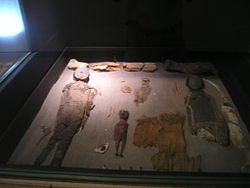
| UNESCO World Heritage Site | |
|---|---|
 Chinchorro mummies of the type site in Arica, Chile | |
| Location | Chile |
| Criteria | Cultural: (iii)(v) |
| Reference | 1634 |
| Inscription | 2021 (44th Session) |
The Chinchorro mummies are mummified remains of individuals from the South American Chinchorro culture, found in what is now northern Chile. They are the oldest examples of artificially mummified human remains, having been buried up to two thousand years before the Egyptian mummies. The earliest mummy that has been found in Egypt dates from around 3000 BCE,[1] while the oldest purposefully artificially preserved[2] Chinchorro mummy dates from around 5050 BCE.
The oldest naturally mummified corpse associated with the Chinchorro civilization was recovered from the Atacama Desert and is dated from around 7020 BCE.[3]
Shell midden and bone chemistry suggest that 90% of the people's diet was seafood. Many ancient cultures of fishermen existed, tucked away in the arid river valleys of the Andes, but the Chinchorro made themselves unique by their dedicated preservation of the dead.
The Chinchorro culture settlements and artificial mummification process in Arica and Parinacota were declared a World Heritage Site by UNESCO in 2021.[2]
- ^ "Wooden coffin yields oldest Egyptian mummy". The News In science. 2003. Retrieved 2011-01-10.
- ^ a b UNESCO (2021). Settlement and Artificial Mummification of the Chinchorro Culture in the Arica and Parinacota Region. Retrieved 2021-07-29.
- ^ Arriaza, Bernardo T. Beyond Death: The Chinchorro Mummies of Ancient Chile. Washington: Smithsonian Institution, 1995. Print.